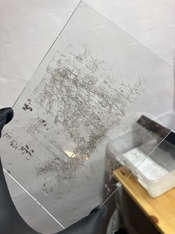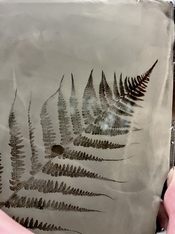Have you noticed some differences in colour on plate depending on what kind of fixer you use? I have read that cyanide fixer yield a more yellow/creamy colour.
I was surpriced that my plates came out with an almost golden tone against a black background. The collodion I use contains cadmium bromide and ammonium iodines.
I have used all kinds of fixers on wet plate, and to be honest, I don't see a whole lot of difference in the result, color-wise. I refuse to play with potassium cyanide as a fixer - it's just too risky for my liking: if you accidentally expose the KCn to an acid, it liberates cyanide gas, and you do NOT want that to happen.
Washing time for plates is 30 minutes if you use Sodium thiosulfate as your fix, and for Ammonium thiosulfate (rapid fix), 20 minutes should be plenty. If you try Potassium cyanide for your fixer, then 10-15 minutes is what is generally recommended for washing. You can use a hypo clearing agent to shorten wash times if you like: 10 grams Sodium sulfite in a liter of water, and soak the plate in that for 2-3 minutes before the final wash (which you can cut to half the recommended times)
I have been working with Collodion since 2017 and have made loads of tintypes, ambrotypes and negatives. I have read (as I'm sure you have too) loads of writings on the Web about how
this developer or
that fixer will dramatically affect the look of your plates, and it is my opinion that you should take 95% of that information with a huge grain of salt. Most of it is exaggeration. Even different recipes of Collodion (different salts in different ratios) will have only a limited effect on your results. Collodion is Collodion. Yes, there are better recipes for tintypes/ambrotypes VS negatives, but even then, the differences are fairly subtle and in a pinch, ANY recipe can be used for any purpose, if you know how to use it properly.
There's a lot of mythology and mystery on the web about the Wet Plate Collodion process. It can be very difficult to sort the wheat from the chaff. I recommend skipping the internet and get a tutorial book and rely on that for guidance. John Coffer's "Doer's Guide" is an excellent choice, and Quinn Jacobson's book is pretty good as well (though I wish he'd hired an editor to organize the book better). Either book will provide you with 99.5% of the information you will ever need. (And yes - I know John Coffer advocates for Potassium cyanide fixer, and that's fine. But I wouldn't have it in MY darkroom)






